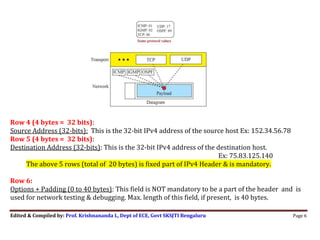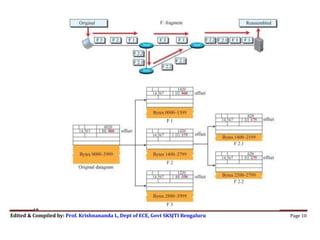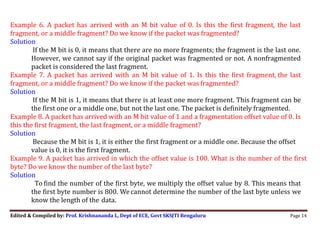COMPUTER COMMUNICATION NETWORKS -IPv4
- 1. Edited & Compiled by: Prof. Krishnananda L, Dept of ECE, Govt SKSJTI Bengaluru Page 1 Introduction About Network Layer Protocols Communication at the network layer is host-to-host (source -to- destination). The packet sent by the source may pass through several LANs or WANs before reaching the destination. A global addressing scheme called logical (IP) addressing in required for this communication. Network layer in the Internet has a main protocol (IPv4) and few auxiliary protocols. IP is responsible for packetizing, forwarding and delivery of a packet (datagram) to the destination. ICMPv4 helps IP to handle some errors, IGMP helps in Multicasting, ARP & RARP help in Logical-to-link layer address translation and viceversa. Communication at the network layer in the Internet is connectionless; so, unreliable. i.e., IP provides “best-effort” service. Best effort means: packets may be duplicated, lost, corrupted, delayed, arrive out-of-order, undelivered or wrongly delivered. IP does not guarantee the delivery of the packet to the destination and does not have mechanisms for flow control or error control. This is the job of upper (Transport) layer.
- 2. Edited & Compiled by: Prof. Krishnananda L, Dept of ECE, Govt SKSJTI Bengaluru Page 2 To summarize: IPv4 is a connectionless, unreliable protocol providing “best- effort” delivery service using “datagram approach” to forward the packets. In this approach, each datagram is treated independently (even though source and destination are same) and may travel through different paths to reach the destination. If reliability is important, IPv4 must be paired with a reliable, connection- oriented higher layer protocol like TCP.
- 3. Edited & Compiled by: Prof. Krishnananda L, Dept of ECE, Govt SKSJTI Bengaluru Page 3 19.1.1 IPv4 Datagram Format
- 4. Edited & Compiled by: Prof. Krishnananda L, Dept of ECE, Govt SKSJTI Bengaluru Page 4 The Internet Protocol version 4 (IPv4) is the delivery mechanism used by the Internet. Packets used by the IP are called datagrams. A datagram is a variable-length packet consisting of two parts: header and payload (data). The header is of variable length from 20 to 60 bytes and contains information essential to routing and delivery. The header is shown as 4-byte sections or rows. The fields of the IPv4 datagram Header are: Row 1 (4 bytes = 32 bits): Version Number VER (4 bits): This field defines the version of the IPv4 protocol. (present value is 0100 =4). Header Length HLEN (4 bits): This field defines the total length of the datagram header in 4- byte words. Since HLEN is 4-bit size, Min. value should be 5 and Max. value is 15 (11112). So, the actual header length in bytes = HLEN value in decimal x 4 (HLEN value multiply by 4) Service Type (8 bits): Originally, this field was referred to as type of service (TOS), which defined how the datagram should be handled. Later, IETF redefined the field to provide differentiated services (DiffServ) to provide QoS. Total Length (16 bits): This 16-bit field defines the total length (header plus payload) of the IP datagram in bytes. Max datagram length is 65535 bytes. Payload (data) Length in bytes = total length – header length =total length –{(HLEN) × 4}
- 5. Edited & Compiled by: Prof. Krishnananda L, Dept of ECE, Govt SKSJTI Bengaluru Page 5 Row 2 (4 bytes = 32 bits): Identification ID (16 bits): This field identifies each datagram originating from the source host. This field is a counter value initialized to a positive number by the source. When the IP protocol sends a datagram, it increments the counter by one. When a datagram is fragmented, the value in the ID field is copied into all fragments, i.e., all fragments of a datagram have the same ID. The ID helps the destination in reassembling the datagram. The combination of ID and source IP address together uniquely specifies the datagram Flags (3 bits): Fragmentation offset (13 bits): These two fields we shall discuss with fragmentation. Row 3 (4 bytes = 32 bits): Time-to-Live (TTL) (8-bits): Used to control the maximum number of hops a datagram can travel in the network before reaching the destination. Its positive number inserted by the source. At every router, this value is decremented by 1 and if it reaches 0, datagram is discarded. Helps to have finite lifetime for a packet instead of looping in the Internet indefinitely. Protocol (8 bits): The network layer carries the payload given by upper layer protocols. This field indicates which other protocol is using the services of IP. When the datagram arrives at the destination, the value of this field helps to identify to which protocol the payload should be delivered. Header Checksum (16 bits): IP includes mechanism for Header error detection (not the payload). Checksum is a method of error detection which is the complement of the sum of other fields calculated using 1s complement arithmetic.
- 6. Edited & Compiled by: Prof. Krishnananda L, Dept of ECE, Govt SKSJTI Bengaluru Page 6 Row 4 (4 bytes = 32 bits): Source Address (32-bits): This is the 32-bit IPv4 address of the source host Ex: 152.34.56.78 Row 5 (4 bytes = 32 bits): Destination Address (32-bits): This is the 32-bit IPv4 address of the destination host. Ex: 75.83.125.140 The above 5 rows (total of 20 bytes) is fixed part of IPv4 Header & is mandatory. Row 6: Options + Padding (0 to 40 bytes): This field is NOT mandatory to be a part of the header and is used for network testing & debugging. Max. length of this field, if present, is 40 bytes.
- 7. Edited & Compiled by: Prof. Krishnananda L, Dept of ECE, Govt SKSJTI Bengaluru Page 7 Fragmentation A datagram can travel through different networks. For ex, if a router connects a LAN to a WAN, it receives a frame in the LAN format and sends a frame in the WAN format. The format and size of the frames vary from one network to another. Each link-layer protocol (802.3, 802.11 etc) has its own frame format and size. When a datagram is encapsulated in a frame, the total size of the datagram must be less than this maximum size called Maximum Transfer Unit (MTU). MTU defined by the restrictions imposed by the hardware and software used in the network. The value of MTU varies from one network to other. For ex., the MTU in 802.3 LAN is 1500 bytes. However, as seen earlier, the maximum size of IP datagram is 65,535 bytes. So, when it is passed through other networks like LAN, the IP datagram needs to be divided into smaller size blocks (called fragments). This process is known as Fragmentation. A datagram may be fragmented several times before it reaches the final destination.
- 8. Edited & Compiled by: Prof. Krishnananda L, Dept of ECE, Govt SKSJTI Bengaluru Page 8 A datagram can be fragmented by the source host or any router in the path. The reassembly of the datagram is done only by the destination host, after it receives all fragments of a datagram. When a datagram is fragmented, each fragment has its own header. The host or router that fragments a datagram must change the values of three fields: flags, fragmentation offset, and total length. The rest of the fields are copied from the original datagram. We shall now look into fields of IPv4 Header related to fragmentation Row 2 of the Header: Flags (3 bits): This field defines 3 flags. The leftmost bit is reserved (not used). The second bit (D bit) is called the do not fragment bit. If its value is 1, the machine must not fragment the datagram. If its value is 0, the datagram can be fragmented if necessary. The third bit (M bit) is called the more fragment bit. If its value is 1, it means the datagram is not the last fragment; there are more fragments after this one. If its value is 0, it means this is the last or only fragment. Fragmentation Offset (13 bits): This field shows the relative position of this fragment with respect to the whole datagram. It is the offset of the data in the original datagram measured in units of 8 bytes. Fig 19.6 shows a datagram with a size of 4000 bytes divided into 3 fragments. The bytes in the original datagram are numbered 0 to 3999. The first fragment carries bytes 0 to 1399. The offset for this datagram is 0/8 = 0. The second fragment carries bytes 1400 to 2799; the
- 9. Edited & Compiled by: Prof. Krishnananda L, Dept of ECE, Govt SKSJTI Bengaluru Page 9 offset value for this fragment is 1400/8 = 175. Finally, the third fragment carries bytes 2800 to 3999. The offset value for this fragment is 2800/8 = 350. Note: The length of the offset field is 13 bits and cannot represent a sequence of bytes greater than 8191. So, choose the size of each fragment so that the first byte number is divisible by 8 Fig. 19.7 shows detailed Fragmentation of Fig.19.6. The value of the ID field is the same in all fragments. In the “flag” field, the M bit is set (logic 1) for all fragments except the last. Also, the value of the offset field for each fragment is shown. Although the fragments arrived out of order at the destination, they can be correctly reassembled. What happens if a fragment itself is fragmented? In this case, the value of the offset field is always relative to the original datagram. For ex, the second fragment is itself fragmented into two fragments of 800 bytes and 600 bytes, but the offset shows the relative position of the fragments to the original data
- 10. Edited & Compiled by: Prof. Krishnananda L, Dept of ECE, Govt SKSJTI Bengaluru Page 10
- 11. Edited & Compiled by: Prof. Krishnananda L, Dept of ECE, Govt SKSJTI Bengaluru Page 11 Example 1: An IPv4 packet has arrived with the first 8 bits as (01000010)2. The receiver discards the packet. Why? Solution: There is an error in this packet. The 4 leftmost bits (0100)2 show the version, which is correct. The next 4 bits (0010)2 show an invalid HLEN value (2). The minimum HLEN value has to be 5, because min. number of bytes in the header must be 20. The packet has been corrupted in transmission. Example 2: In an IPv4 packet, the value of HLEN is (1000)2. How many bytes of options are being carried by this packet? Solution: The HLEN value is 8, the total number of bytes in the header is 8 × 4 = 32 bytes. The first 20 bytes are the base header. So, the next 12 bytes are the options. Example 3: In an IPv4 packet, the value of HLEN is 5, and the value of the total length field is (0028)16. How many bytes of data are being carried by this packet? Solution: The HLEN value is 5. So the header size is 5 × 4 = 20 bytes (no options). The total length is (0028)16 or 40 bytes, which means the packet is carrying 20 bytes of data (40 − 20). Example 4: An IPv4 packet has arrived with the first few hexadecimal digits as shown. (460000320008000005062…)16. Compute the following: a) Header length b) Data length c) How many bytes in the options d) ID of the packet? e) The number of hops packet can travel? f) The data belong to what upper-layer protocol?
- 12. Edited & Compiled by: Prof. Krishnananda L, Dept of ECE, Govt SKSJTI Bengaluru Page 12 Solution Divide the given data into Row1 bits, Row2 bits etc. Row1 (4 bytes): 46 00 0032 Row2 (4 bytes): 0008 0000 Row3:05 06…… Row1 gives, protocol version, HLEN, service type and total length. a) Header length in bytes = HLEN x 4 = 6x4 = 24 bytes b) Total length is 003216 = 50 bytes. So, data length = total length – header length = 50-24 = 26 bytes c) Header length is 24 bytes. Mandatory 20 bytes. So, Options = 24-20 = 4 bytes Row2 gives ID, Flags etc d) ID of the packet is: 8 Row3 gives TTL, Protocol type etc e) The TTL field is (05)16. So, packet can travel 5 hops before getting discarded. f) The protocol field has the value (06)16, so, the upper-layer protocol is TCP. Example 5: Checksum calculation for an IPv4 header without options. Solution: The header is divided into 16-bit sections. All the sections are added and the sum is complemented after wrapping the leftmost digit. The result is inserted in the checksum field. The calculation of wrapped sum and checksum can also be done hexadecimal. Wrapped Sum= Sum Mod FFFF Checksum=FFFF—Wrapped Sum
- 13. Edited & Compiled by: Prof. Krishnananda L, Dept of ECE, Govt SKSJTI Bengaluru Page 13
- 14. Edited & Compiled by: Prof. Krishnananda L, Dept of ECE, Govt SKSJTI Bengaluru Page 14 Example 6. A packet has arrived with an M bit value of 0. Is this the first fragment, the last fragment, or a middle fragment? Do we know if the packet was fragmented? Solution If the M bit is 0, it means that there are no more fragments; the fragment is the last one. However, we cannot say if the original packet was fragmented or not. A nonfragmented packet is considered the last fragment. Example 7. A packet has arrived with an M bit value of 1. Is this the first fragment, the last fragment, or a middle fragment? Do we know if the packet was fragmented? Solution If the M bit is 1, it means that there is at least one more fragment. This fragment can be the first one or a middle one, but not the last one. The packet is definitely fragmented. Example 8. A packet has arrived with an M bit value of 1 and a fragmentation offset value of 0. Is this the first fragment, the last fragment, or a middle fragment? Solution Because the M bit is 1, it is either the first fragment or a middle one. Because the offset value is 0, it is the first fragment. Example 9. A packet has arrived in which the offset value is 100. What is the number of the first byte? Do we know the number of the last byte? Solution To find the number of the first byte, we multiply the offset value by 8. This means that the first byte number is 800. We cannot determine the number of the last byte unless we know the length of the data.
- 15. Edited & Compiled by: Prof. Krishnananda L, Dept of ECE, Govt SKSJTI Bengaluru Page 15 Example 10. A packet has arrived in which the offset value is 100, the value of HLEN is 5, and the value of the total length field is 100. What are the numbers of the first byte and the last byte? Solution The first byte number is 100 × 8 = 800. The total length is 100 bytes, and the header length is 20 bytes (5 × 4), which means that there are 80 bytes in this datagram. If the first byte number is 800, the last byte number must be 879.
- 16. Computer Communication Networks- 17EC64 Module 3 WLANs Compiled by: Prof. Krishnananda L, Dept of ECE, Govt SKSJTI, Bengaluru Page 16 19.1.4 Security of IPv4 Datagrams No security was provided for the IPv4 protocol when it was originally developed. There are three security issues/attacks applicable to the IP protocol: Packet sniffing, packet modification, and IP spoofing. 1) Packet Sniffing An intruder may intercept an IP packet and make a copy of it. Packet sniffing is a passive attack, in which the attacker does not change the contents of the packet. This type of attack is very difficult to detect because the sender and the receiver may never know that the packet has been copied. One solution is encryption of the packet. The attacker may still sniff the packet, but the content is cannot be deciphered. 2) Packet Modification The second type of attack is to modify the packet. The attacker intercepts the packet, changes its contents, and sends the new packet to the receiver. The receiver believes that the packet is coming from the original sender. This type of attack can be detected using a data integrity mechanism. 3) IP Spoofing An attacker can masquerade as somebody else and create an IP packet that carries the source address of another computer. An attacker can send an IP packet to a bank pretending that it is coming from one of the customers. This type of attack can be prevented using an origin authentication mechanism. IPSec (IP Security Protocol) The IP packets can be protected from the previously mentioned attacks using a protocol called IPSec (IP Security). This protocol, which is used in conjunction with the IP protocol, creates a connection-oriented service between two entities in which they can exchange IP packets without worrying about the attacks. IPSec provides the following four services:
- 17. Computer Communication Networks- 17EC64 Module 3 WLANs Compiled by: Prof. Krishnananda L, Dept of ECE, Govt SKSJTI, Bengaluru Page 17 ❑ Defining Algorithms and Keys. The two entities that want to create a secure channel between themselves can agree on some available algorithms and keys to be used for security purposes. ❑ Packet Encryption. The packets exchanged between two parties can be encrypted for privacy using one of the encryption algorithms and a shared key agreed upon. This makes the packet sniffing attack useless. ❑ Data Integrity. Data integrity guarantees that the packet is not modified during the transmission. If the received packet does not pass the data integrity test, it is discarded. This prevents the second attack, packet modification, described above. ❑ Origin Authentication. IPSec can authenticate the origin of the packet to be sure that the packet is not created by an imposter. This can prevent IP spoofing attacks.

















